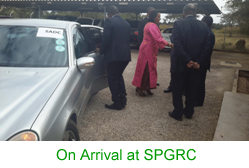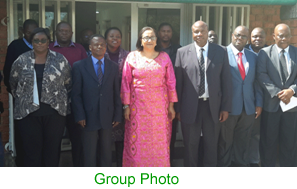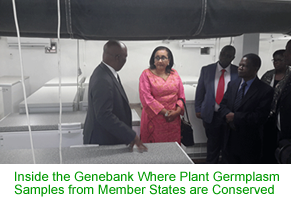 The SADC Executive Secretary, Dr Stergomena Tax visited the SADC Plant Genetic Resources Centre (SPGRC) in Lusaka, Zambia on 26th May 2016. She was met on arrival by the SPGRC Board Chairperson, Mr Godfrey Mwila and senior staff of the Centre. Dr Tax was making her first visit to SPGRC in order to acquaint herself with the institution.
The SADC Executive Secretary, Dr Stergomena Tax visited the SADC Plant Genetic Resources Centre (SPGRC) in Lusaka, Zambia on 26th May 2016. She was met on arrival by the SPGRC Board Chairperson, Mr Godfrey Mwila and senior staff of the Centre. Dr Tax was making her first visit to SPGRC in order to acquaint herself with the institution.
In his welcoming remarks, the Head of SPGRC, Dr Paul Munyenyembe informed the Executive Secretary of the uniqueness of the 27 year old SPGRC as a regional genebank in Africa, thanks to the political support that the Centre enjoys from SADC Member States. He listed a number of achievements attained over the years which include provision of standard genebank equipment and training of staff in plant genetic resources (PGR) management at  different levels both at SPGRC and in the Member States. He also informed the ES that about 45,000 seed samples were currently conserved in SADC Member States, of which 18,000 are at the SPGRC Base Collection for long-term storage. SPGRC has initiated the development of community seed banks in Member States and has also developed a web-based documentation system where PGR data can be exchanged instantly online.
different levels both at SPGRC and in the Member States. He also informed the ES that about 45,000 seed samples were currently conserved in SADC Member States, of which 18,000 are at the SPGRC Base Collection for long-term storage. SPGRC has initiated the development of community seed banks in Member States and has also developed a web-based documentation system where PGR data can be exchanged instantly online.
Dr Munyenyembe elaborated that despite numerous successes and achievements, the Centre still faces many challenges, including, the outdated MoU Establishing SPGRC, unreliable power supply, inadequate funding and infrastructure; and inadequate human capacity.
In her response and address to the staff, the Executive Secretary expressed her pleasure at visiting SPGRC for the first time since ascending to the position of Executive Secretary of the SADC Secretariat in 2013. She promised that the visit to the Centre, was not going to be her last.
She expressed her interest about the achievements made by SPGRC over the years and applauded the Centre for being at the forefront in coordinating the development and harmonization of plant genetic resources policies in the region. The Executive Secretary appreciated being accorded the opportunity to see first-hand the facilities used for conserving the plant genetic resources of our region. She said she was confident that the genetic resources of SADC will continue to be conserved for many generations to come and will also continue to contribute to the region's food and nutrition security.
 The Executive Secretary commended SPGRC for its achievements and urged the Centre to shift its focus from mere conservation to greater utilization of the conserved material as a contribution to food security in the region. She also urged the Centre to conceive innovative approaches to additional resource mobilization in order to sustain its activities in Member States, especially in the face of the declining budget as a result of financial challenges faced by Member States.
The Executive Secretary commended SPGRC for its achievements and urged the Centre to shift its focus from mere conservation to greater utilization of the conserved material as a contribution to food security in the region. She also urged the Centre to conceive innovative approaches to additional resource mobilization in order to sustain its activities in Member States, especially in the face of the declining budget as a result of financial challenges faced by Member States.
For SPGRC to maintain its status as a regional centre of excellence in plant genetic resources conservation, the Executive Secretary urged the Management and staff to be up to date with the best technologies and practices that meet international standards in the area of plant genetic resources conservation.
In his remarks, the SPGRC Board Chairperson, Mr Godfrey Mwila thanked the Executive Secretary on behalf of the Board, Management and staff for finding time in her busy schedule, to visit the Centre. He welcomed the Executive Secretary’s commitment to be an Ambassador to drum up support for the Centre. He said that the Centre was very important for addressing some of the topical issues such as climate change and food and nutrition security. He therefore urged SADC Secretariat’s support for positioning SPGRC to play regional and global roles not only in conservation but also in sustainable utilization of germplasm materials.
 Mr Mwila emphasized the need for expanding Genebank space that wil include construction of a biotechnology laboratory that will see the Centre using modern technologies to conserve vegetatively propagated materials, conducting more accurate characterization using molecular markers, etc. He urged the Management to take advantage of the ongoing review of SADC Secretariat structure so that it encompasses issues of operation and management of the Centre.
Mr Mwila emphasized the need for expanding Genebank space that wil include construction of a biotechnology laboratory that will see the Centre using modern technologies to conserve vegetatively propagated materials, conducting more accurate characterization using molecular markers, etc. He urged the Management to take advantage of the ongoing review of SADC Secretariat structure so that it encompasses issues of operation and management of the Centre.
During her visit, the Executive Secretary held discussions with Technical Departments that include Ex-situ Conservation, In-situ conservation, and Documentation & Information. As part of the discussions, she was introduced to the regional Genebank and the field where germplasm materials are multiplied and regenerated.

